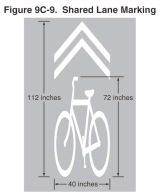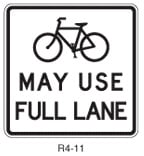
this one in San Francisco, are
now officially recognized by
the FHWA.
(Photo © J. Maus)
This morning the Federal Highway Administration released a 135-page comprehensive update to their Manual on Uniform Traffic Control Devices (MUTCD), a standards guide that has driven (pun intended) the design of traffic controls in America for over three decades.
In a press statement, U.S. Transportation Secretary Ray LaHood said the updates — the first major changes since 2003 — where part of a “continuing effort to improve safety on the nation’s roads and bridges”. Several of the new updates will make it easier for city traffic engineers across the country to implement signs, signals, and markings that improve conditions for biking and walking.
Some of the key changes to the MUTCD that benefit bike and foot traffic are:
- the addition of shared-lane markings (also known as “sharrows”),
- the addition of “Bicycles May Use Full Lane” signage,
- an improved U.S. Bike Route sign,
- the addition of bike route guide signs ,
- new guidance for deciding when a new traffic signal can be installed,
- and changing the formula used to calculate crosswalk times to give walkers more time.
Sec. LaHood specifically referenced these changes in today’s press statement:
“By requiring better pavement markings which can increase bike lane safety, and extending walk times for pedestrians at crosswalks, the updated MUTCD furthers the “complete streets” concept – an effort long championed by the FHWA [some folks might chuckle a bit at that — Ed.] to ensure roads accommodate all types of travel, not just automobiles.”

from the MUTCD.
For more on shared-lane markings, here’s a snip from the official Federal Register:
This pavement marking indicates the appropriate bicyclist line of travel, and cues motorists to pass with sufficient clearance, and is based on field research conducted in San Francisco, CA. The purpose of this marking is to reduce the number and severity of bicycle- vehicular crashes, particularly crashes involving bicycles colliding with suddenly opened doors of parked vehicles.
Portland City Traffic Engineer Rob Burchfield seemed pleased with the news about shared-lane markings when I spoke to him about it this morning. “This absolutely makes it easier and more straightforward for us to put them in.” Burchfield said PBOT plans to install 2,000 shared lane markings in their bike boulevard projects in the coming years (thanks to a federal stimulus grant that’s funding the markings and signage of the bike boulevards).

numbered bike routes.
Adventure Cycling’s U.S. Bicycle Route System effort got strengthened a bit by this MUTCD update. The FHWA decided to revise the U.S. Bike Route Sign by putting a larger bicycle symbol on the top part of the sign with a smaller number below it. The reason for the change, “is to present an immediate impression of a ‘bicycle numbered route’ rather than a ‘highway numbered route which can also be used by bicyclists'”.
Another sign that the FHWA is slowly moving away from their auto-centric roots is a change to a section titled Adequate Roadway Capacity. The new MUTCD includes a paragraph offering guidance to engineers against taking a widen-it-first approach to adding capacity. From the Federal Register:
“… add a paragraph… that additional methods for increasing roadway capacity that do not involve widening a signalized intersection should be carefully evaluated. Such methods could include revising pavement markings or lane-use assignments where appropriate.”
The FHWA cited the need to recommend “lower cost options” and they also agreed with comments that “any impacts to bicyclists should also be considered” in all projects that aim to increase roadway capacity.

Bike route guide signs.
|

This will please a lot of people.
|
One source I spoke to this morning said the most important change to the MUTCD has to do with criteria used to determine when a traffic signal can be installed. The new MUTCD makes it easier for engineers to install traffic signals where bikeways and trails cross larger arterial streets based not just on volume of non-motorized traffic, but on how long of a delay they experience.
This is crucial, because engineering analysis of some crossings would yield low counts of biking and walking traffic simply because the crossing is so intimidating and dangerous. Now, with the new rules, this catch-22 is avoided and the decision is much more friendly to biking and walking traffic that it has been in the past.
This MUTCD update includes a lot of revisions and additions to how the FHWA handles non-motorized transportation and it shows their acknowledgment of — not just external pressures to innovate more quickly — but of a changing traffic mix in America.
You can peruse the chapter in the MUTCD devoted to “Traffic Controls for Bicycle Facilities” on the FHWA website.

